Fire Safety: Luxury London High-Rise vs. Margate Estate.
Gazing up at the shimmering Landmark Pinnacle on London’s Isle of Dogs, it’s challenging to tilt your head back far enough to see all the way to the summit.
Completed in 2020, it is the tallest mainly residential building in Europe, soaring 784ft (239m) and 75 floors into the sky. It has a gym, roof terrace and designated Pilates area.
Inside, one of three concierges asks – without smiling – who I’m visiting, and I’m shown to one of the lifts. Apparently they don’t usually let you in without a name.
Seven years ago, the catastrophic fire at Grenfell Tower led to changes in how high-rises should be designed to keep residents safe during a blaze.
But problems persist in existing blocks.
I visited the Landmark Pinnacle as well as Invicta House, a council-owned block on an estate just outside Margate. While there are significant differences, concerns have crept up at both.
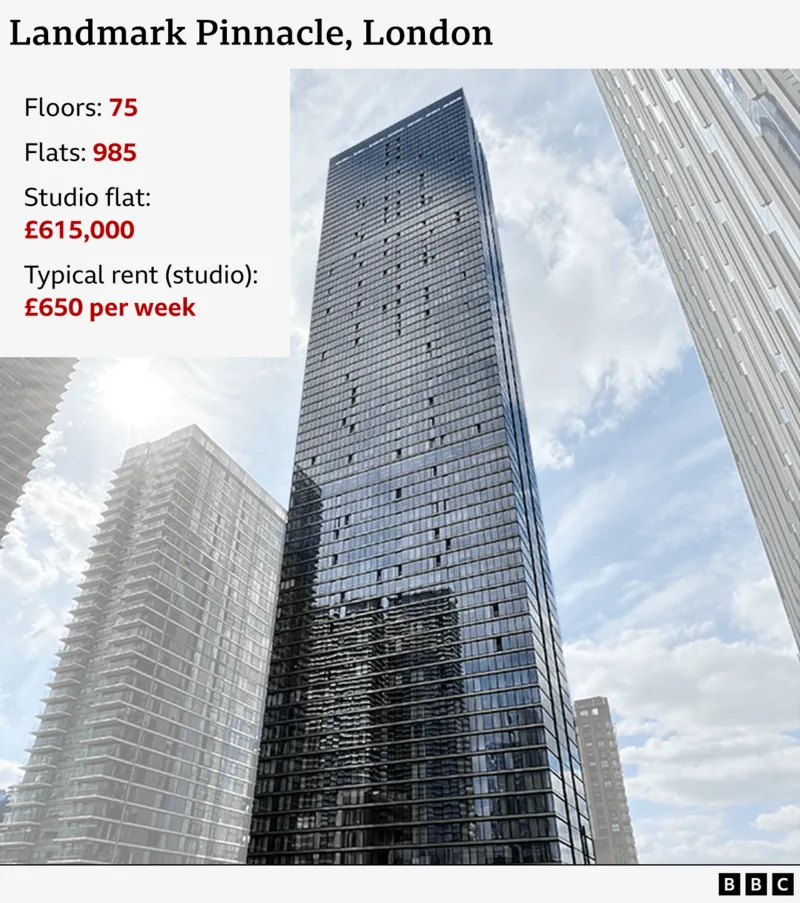
Invicta House, a 14-story building constructed in the 1960s on the Isle of Thanet in East Kent, stands austerely among predominantly low-rise housing. There are no doormen, and I followed some residents through a sparsely decorated lobby.
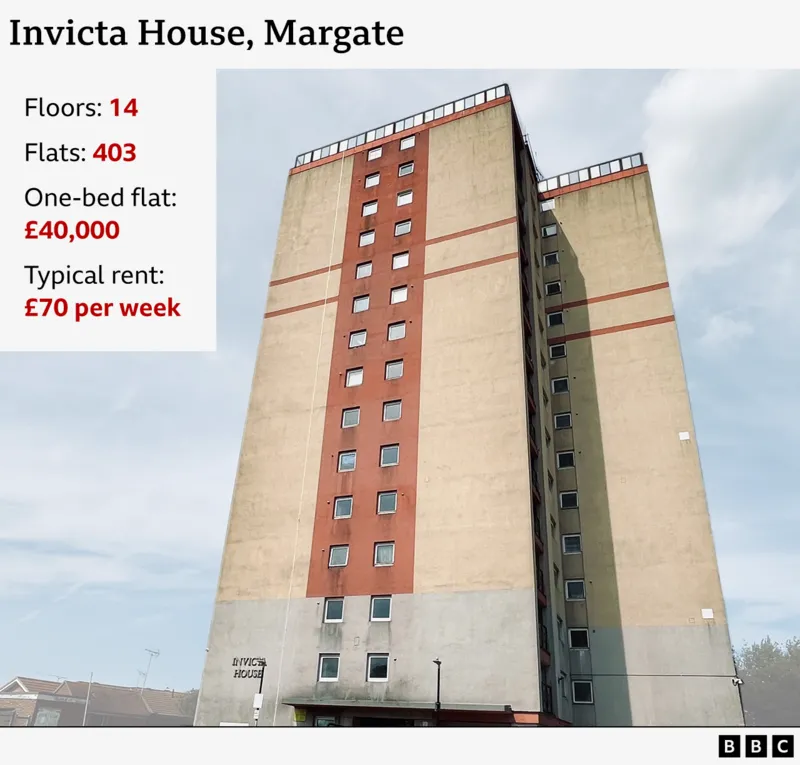
The two towers provide breathtaking views—one overlooking the Kent coast and the other capturing the winding Thames. Yet, the economic disparity between the residents of Invicta House, who rely on minimum wage or benefits, and the city workers along with affluent foreign students at the Landmark Pinnacle is undeniable.
In fact, the price of a studio apartment at the Landmark Pinnacle is equivalent to purchasing 15 one-bedroom flats at Invicta House, highlighting the stark contrast in living conditions. This significant price difference underscores the varying lifestyles and financial situations of the residents in these two buildings.
David Bond, a resident of Invicta House, takes pride in his military service during the Cold War in Germany. He is a council tenant and has decorated his sideboard with two model tanks as a nod to his past. Bond appreciates the quietness of his home, where he feels that people tend to keep to themselves.
Read Also: Trump’s Sentencing is Delayed Until After the Election.
However, he acknowledges the challenges within the community. His neighbors include individuals struggling with addiction and those recently released from prison, which contributes to a complex living environment. Bond mentions that he finds the prevalence of dogs in the building to be excessive.
Several residents have pointed out the unpleasant odors in the lifts, which they attribute to dog urine. This issue has become a common complaint, reflecting the difficulties faced by those living in the building.
Overall, while both towers offer impressive views, the experiences of their residents differ greatly, shaped by their economic circumstances and the dynamics of their communities.

Residents of Invicta House and Landmark Pinnacle share a significant commonality: their complete dependence on lifts. This reliance highlights the challenges they face in their daily lives. For many, including those with health issues, the functionality of these lifts is crucial for maintaining their independence and quality of life.
At Invicta House, John—who prefers not to disclose his real name—describes the ongoing frustrations with the building’s two lifts, which service odd and even floors. He notes that these lifts are prone to frequent breakdowns, forcing engineers to scavenge parts from one lift to repair the other. This situation creates a persistent uncertainty for residents who rely on them.
John, who lives with several medical conditions, finds that taking the stairs is simply not an option. The fear of being unable to return home due to malfunctioning lifts looms over him. This anxiety can lead to significant disruptions in his routine and sense of security.
As a result, there have been times when John has had to stay with friends instead of returning to his own home. This reliance on others underscores the broader implications of lift failures, impacting not just individual lives but also the community’s overall well-being.
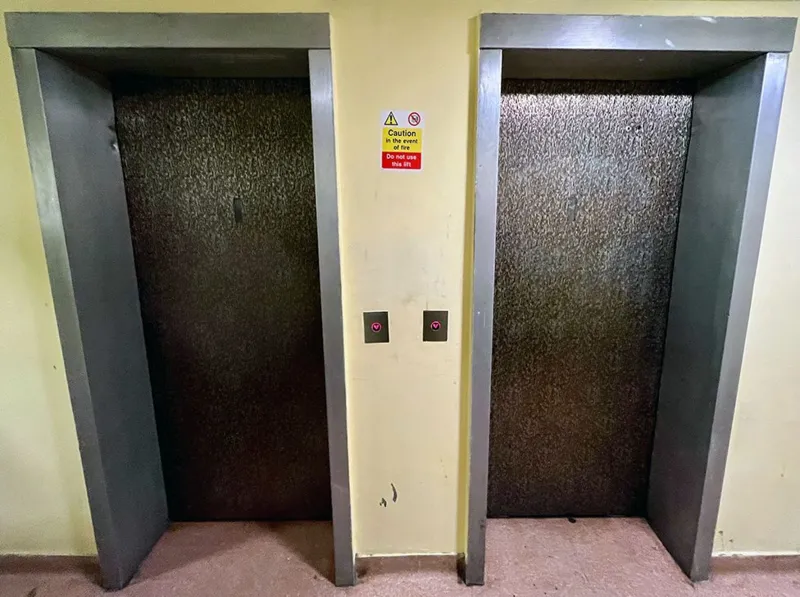
At the Landmark Pinnacle, a lift swiftly transports me to the 13th floor. Two years ago, Guy Benson, a young city employee and part-time Liberal Democrat activist, purchased a 25% share of the lease for his £700,000 flat through a shared ownership scheme.

Landmark Pinnacle has faced issues with some of its lifts, including one that is currently out of service. Guy explains that these problems are typical during the initial stages of operation, comparing the situation to constructing a large machine where everything may not function perfectly right away. He believes that having more lifts would likely improve the overall experience, especially since the building already has seven.
The challenges with the lifts have led to some residents considering alternative options. However, using the stairs can be quite intimidating. From the 75th floor, the view down the stairwell reveals landings that seem to extend infinitely, making the prospect of descending feel overwhelming.
Despite these challenges, Guy remains optimistic about the building’s functionality. He emphasizes that such teething problems are common in new constructions and that improvements will come with time. As residents adjust to the building’s amenities, he is hopeful that the lift issues will soon be resolved, enhancing the overall living experience at Landmark Pinnacle.
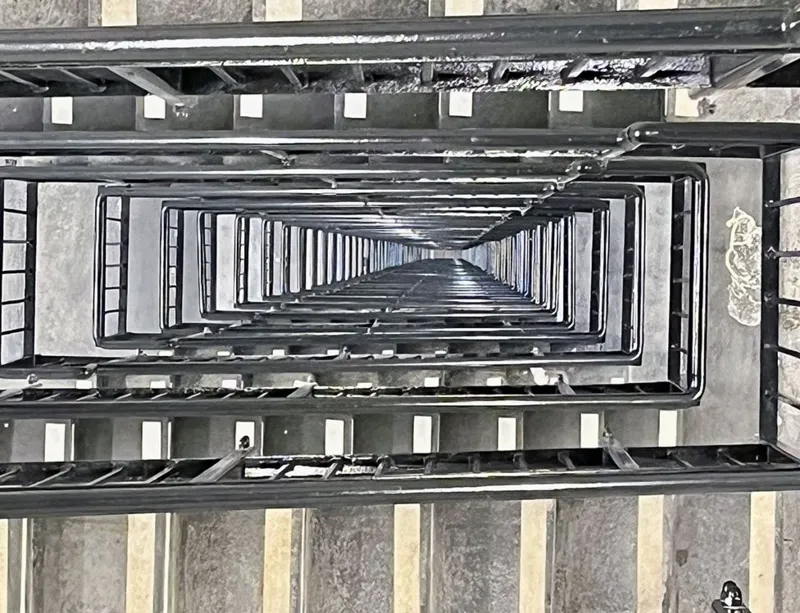
The tragic fire at Grenfell Tower in 2017 highlighted major concerns about the design and operation of high-rise buildings, particularly regarding emergency evacuation procedures. As a result, new regulations require all buildings over 59ft (18m) constructed from 2026 onwards to have two staircases – one for firefighters and one for residents. However, some existing and recently built towers, such as Invicta House and Landmark Pinnacle, still have only a single staircase, as adding a second was deemed impractical in those cases.
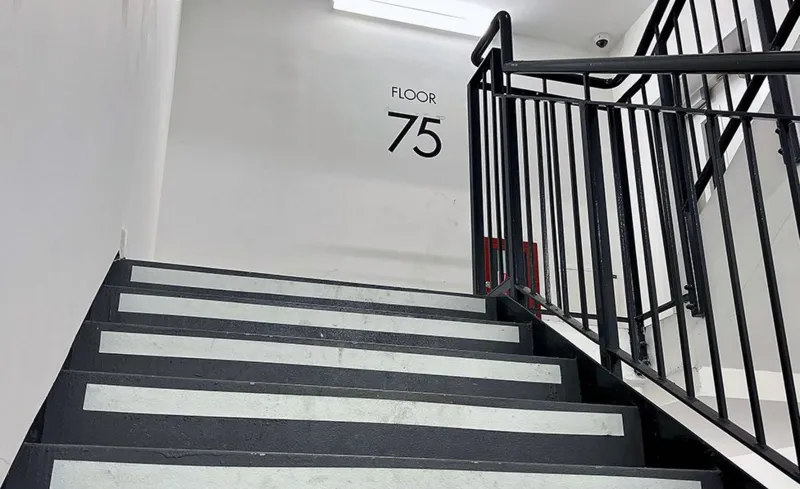
Both towers have had recent fires.
In 2021, a candle set light to a flat at the Landmark Pinnacle on a floor in the 30s. Some residents couldn’t hear a fire alarm and like those at Grenfell had to decide to stay put or get out.
The building has a “stay put” policy because it is designed so fires can’t spread between flats. Alarms don’t even go off on unaffected floors.
Yet in Facebook messages shown to the BBC, residents – some of whom could smell burning and see fire trucks gathering outside – appear confused about what to do. Grenfell was doubtless on everyone’s mind.
The fire was swiftly put out, with the help of the in-built sprinkler system.
And should there be another fire, Guy Benson has faith that the way this building has been designed will keep him safe.
“I don’t feel at risk at all,” he says.
At Invicta House there has been a spate of fires, apparently started deliberately, in chutes used to send rubbish to the ground floor. Jane, one of the residents, describes opening her door to a thick wall of smoke.
But seven years after Grenfell – and in contrast to Landmark Pinnacle – Invicta House is still a fire risk. In particular, the combustible polystyrene insulation on its walls. Planning permission to remove it was granted in March, but the work, predicted to start in April this year, still hasn’t.
The rubbish chutes have been modified to deter arsonists, and a trained fire warden patrols around the clock. Like Grenfell, there’s a risk that any fire would spread throughout this building, so residents are advised to “get out” if the alarms go off – and that means taking the stairs.
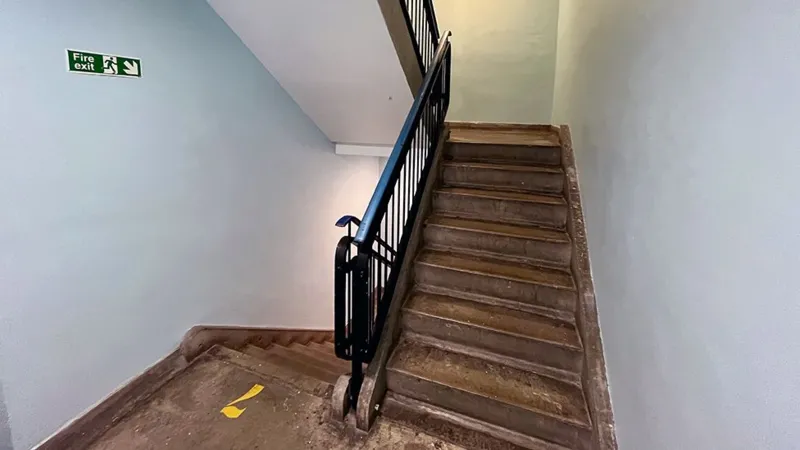
“I can’t get down the stairs,” says Jane, “I’m on crutches.” Last time the fire alarm went off, she says she just shut the door.
On another floor an empty wheelchair sits on a landing, a symbol of the vulnerability of many in the building.
The residents mainly rent, so aren’t stuck with a flat they can’t sell like many around the country – but most have no other housing options.
John – who moved here after a fire in his previous accommodation – pays £70 a week rent.
“I’m lucky to have a place that I can afford,” he says, “and when I close the door I’ve closed the outside world out.”
The difference in fire safety experiences between tower block residents at opposite ends of the economic spectrum greatly concerns Dr Barbara Lane, one of the Grenfell Tower public inquiry’s expert witnesses, who argues that removing this “inequity” should be a priority.
To do so would require a comprehensive examination of the existing fire risks of older buildings, proactively removing them, and thinking more carefully about how vulnerable people will get out.
For those tenants who need extra help, Thanet District Council offers a Personal Emergency Evacuation Plan. This is already a recommendation of the Grenfell Tower public inquiry, and the government has recently announced that offering an evacuation plan is to become a legal requirement for building owners.
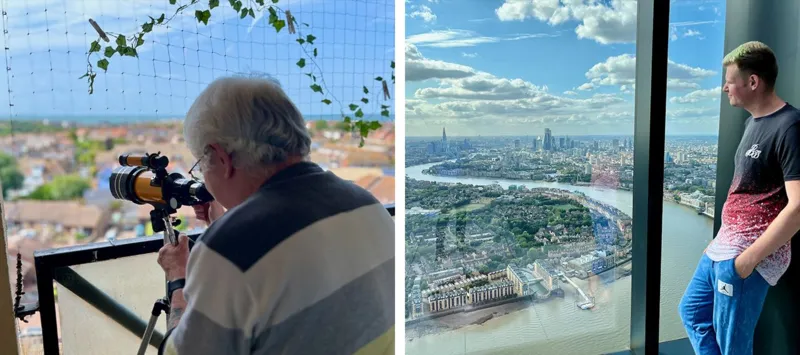
The residents of the Landmark Pinnacle and Invicta House have something else in common – a degree of powerlessness.
They all live in a building they do not own. The tenants in Margate rely on Thanet District Council. The leaseholders in east London, on their building manager.
On the 13th floor of the Landmark Pinnacle, Guy Benson studies a spreadsheet at a window which looks out over an expanse of south London.
He is worried about his growing energy bills and service charges – despite not paying extra for access to the Landmark’s gym and private cinema. He agrees there is a power imbalance.
“You’re never able to negate it, you do have less control, ” he says. “Being able to understand the system and the levers you have to pull is absolutely an advantage – but you shouldn’t have to become a property law expert.”
Another resident at the Landmark Pinnacle, Alex – not his real name – echoes the view of many leaseholders in England and Wales of their landlords.
“We feel like we are getting ripped off. There’s nothing we can do. It’s like paying taxes but without being able to get rid of your government.”
Alex wants the Landmark Pinnacle’s residents to exercise their Right to Manage. He has asked the building managers, Rendall & Rittner, to contact the owners of each flat to let them know about his plan – but says they have refused. Alex reckons the management company is protecting its own interests. However, Rendall & Rittner, told the BBC it has not received any requests from residents about Right to Manage.
The government plans further reforms to leasehold laws building on changes introduced by the Conservatives.
In Kent, David Bond, who has a sea view from his balcony, says council officials “build a big wall” when he raises concerns about the lifts and delays to building safety work. He doesn’t blame the housing officers he deals with, but says they are “struggling with regulations”.
“People don’t take us seriously,” he says. “We should stop paying the rent and then it would become serious.”
A spokesperson for the management company stated that the building’s stay-put policy is regularly communicated to all residents and leaseholders, as required by the London Fire Brigade, and is part of the overall fire strategy and risk assessment reviewed by specialists to ensure compliance.
The management company said they strive to keep service charges reasonable, but new Building Safety Act requirements, the cost of living, and the energy crisis have contributed to increasing costs. One of the building’s seven lifts is undergoing general maintenance at no additional cost to leaseholders.
A council spokesperson said the safety of residents is paramount and they work closely with the fire service. Work to replace the external wall insulation at Invicta House is planned to start in May 2025. In 2019, fire protection was upgraded, fire doors were replaced, and the fire alarm system was upgraded, with a shift from a stay-put to a simultaneous evacuation policy in July 2021.
While high-rise living may not be for everyone, some residents expressed appreciation for the sense of community and the practical necessity of building upwards on an island with limited space.





